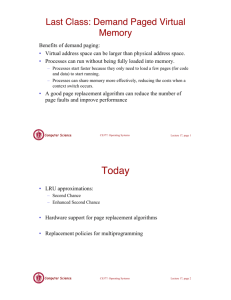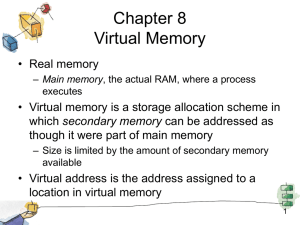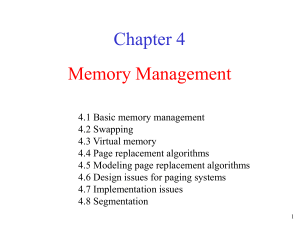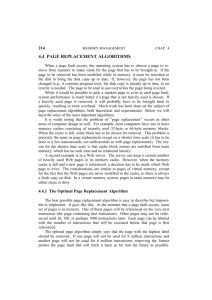Page Replacement - University of Toronto
advertisement
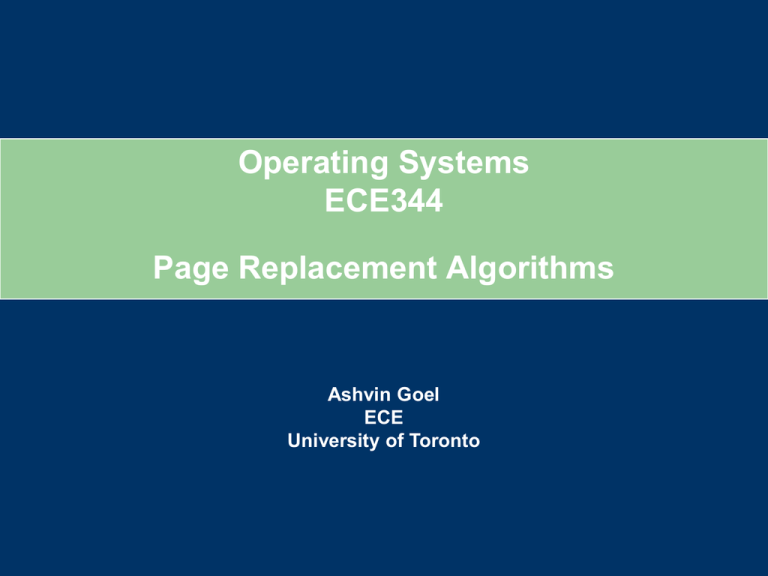
Operating Systems
ECE344
Page Replacement Algorithms
Ashvin Goel
ECE
University of Toronto
Overview
Introduction
Page replacement algorithms
Paging issues
2
Introduction
CPU generates page fault when it accesses address
not in memory, OS allocates memory frames to
programs on demand
If no frame is available, OS needs to evict another
page to free a frame
Which page should be evicted?
o
o
A page miss is similar to a TLB miss or a cache miss
However, a miss may require accessing the disk
So miss handling can be very expensive
Disk access times are at least 1000x memory access times
3
When Will Paging Work?
Paging will only work if it occurs rarely
Paging schemes depend on locality of reference
o
Spatial locality
Programs tend to use a small fraction of their memory, or
Memory accesses are near memory accessed recently
o
Temporal locality
Programs use same memory over short periods of time, or
Memory accessed recently will be accessed again
Programs normally have both kinds of locality
o
Hence, overall cost of paging is not very high
4
Page Replacement Algorithms
Aim is to reduce page misses using smart
replacement algorithms
o
o
Page table, MMU, TLB handling are VM mechanisms
Page replacement is a VM policy
Several Algorithms
o
o
o
o
o
o
Optimal Algorithm
First In First Out (FIFO)
Clock
Least Recently Used (LRU)
Working Set Clock
Page Fault Frequency
5
The Optimal Page Replacement Algorithm
Select page that will not be needed for longest time
o
Why is this algorithm optimal?
Time
Requests
0
1
c
2
a
3
d
4
b
5
e
6
b
7
a
8
b
9
c
Page
0
Frames 1
2
3
a
b
c
d
a
b
c
d
a
b
c
d
a
b
c
d
a
b
c
d
a
b
c
e
a
b
c
e
a
b
c
e
a
b
c
e
a
b
c
e
Page faults
X
10
d
X
6
The Optimal Page Replacement Algorithm
Optimal algorithm is unrealizable
o
o
Don’t know the future of a program!
Don’t know when a given page will be next needed
However, it can be used to compare to compare the
performance of other algorithms
o
How?
7
First In First Out (FIFO)
Replace the page that has been in memory for the
longest time (i.e., replace oldest page)
Time
Requests
0
Page
0
Frames 1
2
3
a
b
c
d
Page faults
1
c
c
2
a
3
d
4
b
5
e
6
b
7
a
8
b
9
c
10
a
a
a
c
c
d
a
b
c
d
a
b
e
d
a
b
e
d
a
b
e
d
a
b
e
d
c
b
e
d
c
b
e
a
X
X
X
8
FIFO Implementation
Implementation
o
Keep list of all page frames in memory
E.g., add linked list in coremap
o
o
When a frame is allocated (e.g., when page is mapped to a
new frame), add frame to the front of list
On a page fault, choose frame at end of list for replacement
Problem
o
The oldest page may be needed again soon
E.g., some page may be important throughout execution, when it
gets old, replacing it will soon cause a page fault
o
Faults may increase if algorithm is given more memory!
Known as Belady’s Anomaly
9
Can We Do Better that FIFO?
We need to know page access pattern in the future
o
o
We can take advantage of locality of reference
Pages that have been accessed in the recent past are likely to
be accessed again and should not be replaced
How can page accesses be tracked?
o
o
Tracking each memory access is very expensive
Tracking page access requires hardware support
10
Tracking Page Accesses
Bits in page table entry allow tracking page accesses
o
Referenced (R) bit
Set by processor when page is read OR written
Cleared by OS/software (not by hardware)
o
Dirty (D) bit
Set by processor when page is written
Cleared by OS/software (not by hardware)
o
OS/hardware must synchronize the TLB bits with PTE bits
What if h/w doesn’t maintain these bits?
o
OS can simulate them
When TLB read fault occurs
– Set referenced bit, make page read-only (why read-only)?
When TLB read-only or write fault occurs
– Set referenced & dirty bits, make page writeable
11
Clock Algorithm
FIFO, while giving second chance to referenced pages
o
o
o
Keep circular list of all page frames in memory
Maintain a clock hand, from where frames are evicted
New frames are added behind the clock hand
On a page fault, when we need to evict a page frame:
o
Choose page starting from clock hand
If referenced bit is set
– Unset referenced bit, continue
Else if referenced bit is not set
– If page is dirty
• Schedule page write, continue
– Else page is clean
• Select it for replacement, done
Advance clock hand to next page
0 0
frame #
0 5
1 1
1 4
0 2
0 3
referenced
bit
12
Least Recently Used (LRU)
Replace page that has been used least recently using
a list of pages kept sorted in LRU order
c
a
b
d
a
c
b
d
d
a
c
b
b
d
a
c
e
b
d
a
b
e
d
a
a
b
e
d
b
a
e
d
c
b
a
e
d
c
b
a
Time
Requests
0
1
c
2
a
3
d
4
b
5
e
6
b
7
a
8
b
9
c
10
d
Page
0
Frames 1
2
3
a
b
c
d
a
b
c
d
a
b
c
d
a
b
c
d
a
b
c
d
a
b
e
d
a
b
e
d
a
b
e
d
a
b
e
d
a
b
e
c
a
b
d
c
X
X
Page faults
X
13
LRU Implementation
Updating LRU list on each memory access is too
expensive
Suppose MMU maintains a counter that is
incremented each clock cycle
o
When page is accessed
MMU writes counter value to the page table entry
This timestamp value is the time of last use
o
On a page fault
Software looks through the page table
Identifies entry with the oldest timestamp
Problem is MMU may not provide such a counter
14
LRU Approximation
OS can maintain a counter in software
Periodically (i.e., timer interrupt), increment counter
o
o
On a page fault
o
o
o
In each page with referenced bit set, write counter
Clear the referenced bit, why?
Software looks through the page table
Identifies entry with the oldest timestamp
If several have oldest time, choose one arbitrarily
Why does this method approximate LRU?
15
Working Set Model
Working set is the set of pages a program needs
currently
To measure working set, look at the last time interval T
o
o
o
o
T is also called working set interval
WS(T) = { pages referenced in interval (now, now – T) }
As T gets bigger, more pages are needed
However, working set varies slowly after a while
Set of pages
accessed
(working set)
# of unique memory
references over time T
16
WSClock
Goal of algorithm is to keep working set in memory, so
few page faults will occur due to locality of reference
Variant of Clock algorithm
o
Each entry contains time of last use rather than just a
referenced bit
17
WSClock
On a page fault, clock sweeps over circular list
o
If referenced bit is set
Update time-of-last-use field to current virtual time
– Virtual time is time application has run
Unset referenced bit, continue
o
Else if referenced bit is not set
Compute age by comparing current time with time-of-last-use
If age of the page is less than working set interval (T)
– continue
Else if page is dirty
– Schedule page write, continue
Else if page is clean
– Select it for replacement, done
Compare with Clock algorithm
18
Page Fault Frequency
Working set clock requires knowing working set
interval for each process
Page fault frequency can provide estimate of working
set needs of a program
o
o
It declines as a program is assigned more pages
Can be used to ensure fairness in working set allocation
Too High: need to give this
program some more frames
Too Low: take some frames
away, give to other programs
19
Page Fault Frequency Algorithm
Measuring page fault frequency:
o
For each thread
On each fault, count fault (f)
– f=f+1
Every second, update faults/second (fe) via aging
– fe = (1 – a) * fe + a * f, f = 0
– 0 < a < 1, when a -> 1, history is ignored, a is weighting factor
Goal: Allocate frames so PFF is equal for programs
o
o
Choose a victim process whose PFF is lowest
Use Clock, LRU to evict a page from victim process
20
Which Algorithm is Best?
Compare algorithms based on a reference string
Run a program
o
Look at which memory addresses are accessed
Pages accessed: 0000001222333300114444001123444
o
Eliminate duplicates
012301401234, Why?
o
Defines the reference string
Use the same reference string for evaluating different
page replacement algorithms
o
Count total page faults
21
Summary
Algorithm
Comment
Optimal
Not implementable, but useful as a benchmark
FIFO
Might throw out important pages
Clock
Realistic
LRU
Excellent, but difficult to implement exactly
Working Set Clock
Efficient working set-base algorithm
Page Fault Frequency
Fairness in working set allocation
22
Paging Issues
Paging and I/O interaction
Paging performance
Thrashing
23
Paging and I/O Interaction
Example: A thread performs a read system call,
suspends during I/O, then another thread runs, has a
page fault
o
o
A frame selected for eviction is the one that is involved in the
read
When I/O returns, OS will copy data from disk to new page!
Solution: Each frame has a 'do not evict me' flag,
called pinned page because the page is pinned/locked
in memory and cannot be evicted during I/O
o
Must always remember to un-pin the page, e.g., after the I/O
completes
24
Paging Performance
Paging works best if there are plenty of free frames
If all pages are full of dirty pages, then two disk
operations are needed for each page fault, one to
swap out the dirty page that is being invalidated, one
to read in the new page
Two methods for improving performance:
o
o
Paging daemon: swap out, in advance
Prefetching: swap in, in advance
25
Paging Daemon
OS can use a paging thread/daemon to maintain a
pool of free frames
Daemon runs replacement algorithm periodically or
when pool reaches low watermark
o
o
Frames in pool still hold previous contents of pages
o
Writes out dirty pages, marks them as free
Frees enough pages until pool reaches high watermark
Can be rescued if page is referenced before reallocation
Issue:
o
If a page is going to be written again, then it would have been
better to not swap it
26
Prefetching
Page faults can only be processed one page at a time,
because disk has to be read one page at a time
Suppose we can predict future page usage at current
fault, then we can prefetch other pages
What if we are wrong?
27
Thrashing
Thrashing is a situation where OS spends most time
paging data from disk, and user programs do not
make much progress
o
System is over-committed:
o
o
A livelock situation
Either, page replacement algorithm is not working
Or, system doesn't have enough memory to hold working set
of all currently running programs
Solution
o
o
o
Run more programs because CPU is idle - no!
Swapping - suspend some programs for a while
Buy more memory
28
Think Time
What the optimal page replacement policy?
o
Is it achievable in practice? Why is it used?
What is the problem with FIFO page replacement?
What is the assumption used by most replacement
policies to improve on FIFO?
What is the working set of a process?
Which of the policies described in these slides take
working set into account?
What happens when working set does not fit in
memory?
29
